Table of contents
What are Times Tables?
Multiplication Tables from 1 to 20
Math Tables 1 to 5

Times Tables 6 to 10

Times Tables 11 to 15

Times Tables 16 to 20

What is a Multiplication chart?

How to read a Multiplication Chart?
- 1. Locate Your Numbers : Identify the two numbers you want to multiply. One will be along the top row, and the other will be in the left column.
- 2. Find the Intersection Point : Trace your finger or eye along the row that contains the first number. Simultaneously, trace your finger or eye down the column that contains the second number.
- 3. Read the Product : The point where the row and column intersect will give you the product of the two numbers.
- 4. Repeat as Needed : If you have more multiplications to perform, repeat the process for each pair of numbers.
- 5. Be Mindful of Zero : If one of the numbers is zero, any product in that row or column will also be zero. It's an important multiplication rule to remember.
- 6. Practice Mental Math : As you become more familiar with multiplication, try to use the chart as a reference while gradually developing your mental math skills. This will help you perform calculations more efficiently.

Multiplication Times Table Chart ( Free Printable )

Multiplication Chart
Why is learning multiplication and times tables important?
- • Foundation for Math Skills : Mastering multiplication tables provides a solid foundation for understanding and performing more complex mathematical operations.
- • Quick Mental Calculations : It enables quick mental calculations, making everyday math tasks, like budgeting and shopping, more efficient.
- • Boosts Confidence : Knowing times tables instills a sense of achievement, boosting children's self-esteem and confidence in their math abilities.
- • Enhances Problem-Solving : It improves problem-solving abilities by breaking down complex problems into manageable steps.
- • Preparation for Advanced Math : Multiplication tables serve as a fundamental building block for higher-level math concepts like long division, fractions, and algebra.
- • Real-Life Applications : Times tables are used in everyday life, from calculating discounts and recipe measurements to planning events, making them practical and essential skills.
Easy tricks and tips to learn multiplication tables
- • Skip-Counting : Practice skip-counting by saying the multiples out loud. For example, when learning the 7 times table, say 7, 14, 21, 28, and so on. This helps to memorize the sequence.
- • Mnemonics : Create mnemonic phrases or stories to remember tricky multiplication facts. For instance, "8 times 7 is 56" can be remembered as "5, 6, pick up sticks."
- • Visual Aids : Use multiplication times table charts to visualize multiplication.
- • Practice with Flashcards : Use flashcards with multiplication facts on one side and answers on the other side as a fun way to learn multiplication tables.
- • Practice Regularly : Consistent practice is key. Set aside a short daily practice session to reinforce the times tables.
- • Multiplication Games : Play multiplication games and quizzes online or with friends and family to make learning interactive and engaging.
- • Use Patterns : Notice patterns in the multiplication tables. Each multiplication table has its own pattern and knowing that can help memorize the tables faster. For instance, every odd number times an odd number is an odd number.
Times Tables 1 to 20 ( Free Printables )
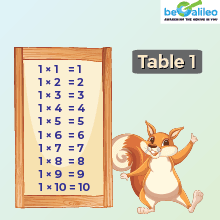
Times Table of 1
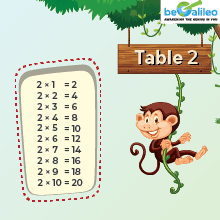
Times Table of 2
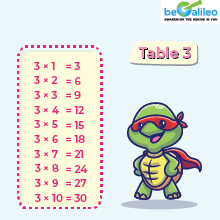
Times Table of 3
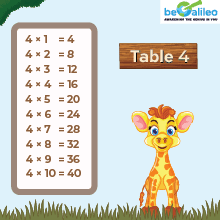
Times Table of 4
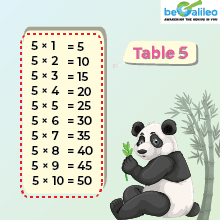
Times Table of 5
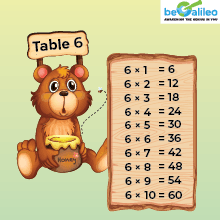
Times Table of 6
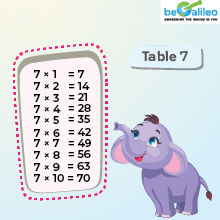
Times Table of 7
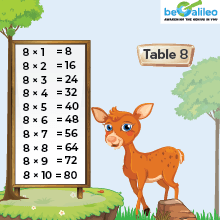
Times Table of 8
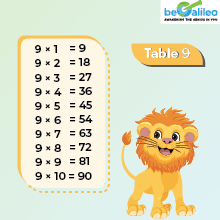
Times Table of 9
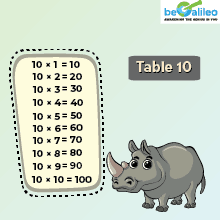
Times Table of 10
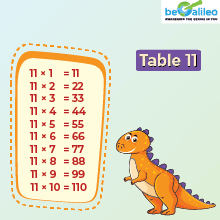
Times Table of 11
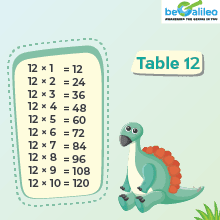
Times Table of 12
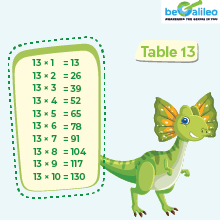
Times Table of 13
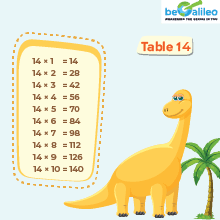
Times Table of 14
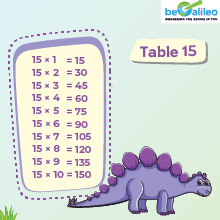
Times Table of 15
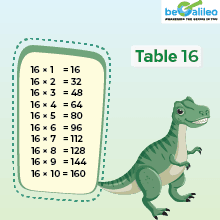
Times Table of 16
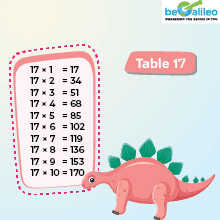
Times Table of 17
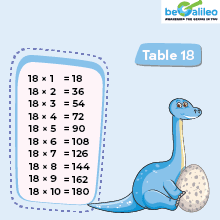
Times Table of 18
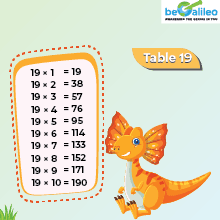
Times Table of 19
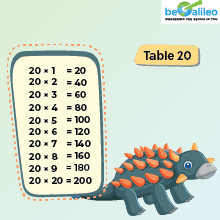
Times Table of 20
Solved examples
- a) 6
- b) 18
- c) 4
- d) 12
Let's call the missing number "a." So, a = 24.
We know that . Hence the missing number is 4.
- a)
- b) 2 + 10 = 12
- c) 10 - 2 = 8
- d)
Look at the multiplication table of 2, and find the product.
Hence, .
- a) Yes
- b) No
Look at the multiplication table of 4 and 5 to find the product of and .
Both are 20.
Hence, Sam is correct, as the product of is the same as the product of
- a)
- b)
- c)
- d)
Look at the multiplication chart to find the products.
and
Hence, the multiplication fact that shows the product as 24 is .
- a) 24
- b) 34
- c) 36
- d) 15
3 packs chocolates/pack.
Using the multiplication table, we can say .
Hence Sarah has 36 chocolates in total.
Practice Problems
Yes
No
49
42
13
None of these
The given multiplication sentences show the correct product.
True
False
45
14
40
54
Frequently Asked Questions
What age group is beGalileo designed for?
Can I try beGalileo before committing to a package?
What is the difference between self-paced and live class options in beGalileo?
How can beGalileo support homeschooling parents?
What curriculum does beGalileo follow?
How can I track my child's progress?
What is the frequency and duration of beGalileo tutoring classes?
Can beGalileo's program be customized for my child's specific learning requirements?
Can your teachers teach topics covered in my child's school curriculum?
Can my child join beGalileo anytime during the year?
What if I am not satisfied with beGalileo's classes after enrolling?
How do I enroll for beGalileo's classes?





